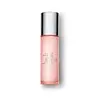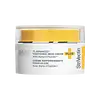What's inside
What's inside
 Key Ingredients
Key Ingredients

 Benefits
Benefits

 Concerns
Concerns

 Ingredients Side-by-side
Ingredients Side-by-side

Water
Skin ConditioningGlycerin
HumectantNiacinamide
SmoothingBiosaccharide Gum-4
Skin ConditioningCocoglycerides
EmollientPropanediol
SolventIsododecane
EmollientPentylene Glycol
Skin ConditioningDimethicone
Emollient3-O-Ethyl Ascorbic Acid
Skin ConditioningOligopeptide-20
Skin ConditioningAcetyl Hexapeptide-8
HumectantOligopeptide-24
Skin ConditioningPentapeptide-4
Skin ConditioningHeptapeptide-15 Palmitate
Skin ConditioningD-Arginyl Tyrosinyl Ornithinyl Phenylalanine
Skin ConditioningCopper Heptapeptide-14 Pantothenate
Skin ConditioningCaesalpinia Spinosa Fruit Extract
Skin ProtectingTocopherol
AntioxidantGlycyrrhiza Glabra Root Extract
BleachingCamellia Sinensis Leaf Extract
AntimicrobialAvena Sativa Kernel Oil
Skin ConditioningAllantoin
Skin ConditioningKappaphycus Alvarezii Extract
Skin ConditioningTocopheryl Acetate
AntioxidantAlgin
MaskingPichia Ferment Lysate Filtrate
HumectantAlpha-Glucan Oligosaccharide
CleansingPullulan
Hydrolyzed Jojoba Esters
Skin ConditioningSodium Oleate
CleansingGlycine Soja Oil
EmollientHydrogenated Lecithin
EmulsifyingParfum
MaskingLactic Acid/Glycolic Acid Copolymer
Skin ConditioningHydrogenated Phosphatidylcholine
EmulsifyingUbiquinone
AntioxidantDextran
Acrylates/Dimethicone Copolymer
Skin ConditioningEthylhexylglycerin
Skin ConditioningAcrylates/C10-30 Alkyl Acrylate Crosspolymer
Emulsion StabilisingMaltodextrin
AbsorbentPhenoxyethanol
PreservativePotassium Hydroxide
BufferingSodium Stearoyl Glutamate
CleansingSodium Phytate
Disodium EDTA
Potassium Sorbate
PreservativePolyvinyl Alcohol
Water, Glycerin, Niacinamide, Biosaccharide Gum-4, Cocoglycerides, Propanediol, Isododecane, Pentylene Glycol, Dimethicone, 3-O-Ethyl Ascorbic Acid, Oligopeptide-20, Acetyl Hexapeptide-8, Oligopeptide-24, Pentapeptide-4, Heptapeptide-15 Palmitate, D-Arginyl Tyrosinyl Ornithinyl Phenylalanine, Copper Heptapeptide-14 Pantothenate, Caesalpinia Spinosa Fruit Extract, Tocopherol, Glycyrrhiza Glabra Root Extract, Camellia Sinensis Leaf Extract, Avena Sativa Kernel Oil, Allantoin, Kappaphycus Alvarezii Extract, Tocopheryl Acetate, Algin, Pichia Ferment Lysate Filtrate, Alpha-Glucan Oligosaccharide, Pullulan, Hydrolyzed Jojoba Esters, Sodium Oleate, Glycine Soja Oil, Hydrogenated Lecithin, Parfum, Lactic Acid/Glycolic Acid Copolymer, Hydrogenated Phosphatidylcholine, Ubiquinone, Dextran, Acrylates/Dimethicone Copolymer, Ethylhexylglycerin, Acrylates/C10-30 Alkyl Acrylate Crosspolymer, Maltodextrin, Phenoxyethanol, Potassium Hydroxide, Sodium Stearoyl Glutamate, Sodium Phytate, Disodium EDTA, Potassium Sorbate, Polyvinyl Alcohol
Water
Skin ConditioningButyrospermum Parkii Butter
Skin ConditioningGlycerin
HumectantBis-Stearyl Dimethicone
EmollientMyristyl Nicotinate
Skin ConditioningTrimethylolpropane Tricaprylate/Tricaprate
EmollientCetearyl Alcohol
EmollientIsononyl Isononanoate
EmollientBehenyl Alcohol
EmollientPropanediol
SolventCaprylic/Capric Triglyceride
MaskingGlyceryl Stearate
EmollientOryza Sativa Bran Extract
Skin ConditioningHelianthus Annuus Extract
EmollientAdenosine
Skin ConditioningArctostaphylos Uva Ursi Leaf Extract
Skin ConditioningOryza Sativa Extract
AbsorbentRosmarinus Officinalis Leaf Extract
AntimicrobialNannochloropsis Oculata Extract
HumectantAcmella Oleracea Extract
Skin ProtectingOryza Sativa Germ Extract
EmollientAcetyl Dipeptide-1 Cetyl Ester
Skin ConditioningGlycine Soja Oil
EmollientPentapeptide-76 Amide
Butylene Glycol
HumectantAcrylates/C10-30 Alkyl Acrylate Crosspolymer
Emulsion StabilisingPolyglyceryl-3 Diisostearate
EmulsifyingSodium Acrylate/Sodium Acryloyldimethyl Taurate Copolymer
Emulsion StabilisingCeteareth-20
CleansingSorghum Bicolor Stalk Juice
Skin ConditioningSclareolide
MaskingPentylene Glycol
Skin ConditioningTrisodium Ethylenediamine Disuccinate
Polyisobutene
Sodium Polystyrene Sulfonate
Emulsion StabilisingHydrated Silica
AbrasiveEthylhexyl Isononanoate
Emollient1,2-Hexanediol
Skin ConditioningPullulan
Caprylhydroxamic Acid
Beta-Glucan
Skin ConditioningCaprylyl Glycol
EmollientSorbitan Oleate
EmulsifyingHydroxyethylcellulose
Emulsion StabilisingCaprylyl/Capryl Glucoside
CleansingSorbitan Laurate
EmulsifyingTocopherol
AntioxidantPEG-40 Stearate
EmulsifyingParfum
MaskingAminomethyl Propanol
BufferingPotassium Sorbate
PreservativeSodium Benzoate
MaskingCitric Acid
BufferingLimonene
PerfumingWater, Butyrospermum Parkii Butter, Glycerin, Bis-Stearyl Dimethicone, Myristyl Nicotinate, Trimethylolpropane Tricaprylate/Tricaprate, Cetearyl Alcohol, Isononyl Isononanoate, Behenyl Alcohol, Propanediol, Caprylic/Capric Triglyceride, Glyceryl Stearate, Oryza Sativa Bran Extract, Helianthus Annuus Extract, Adenosine, Arctostaphylos Uva Ursi Leaf Extract, Oryza Sativa Extract, Rosmarinus Officinalis Leaf Extract, Nannochloropsis Oculata Extract, Acmella Oleracea Extract, Oryza Sativa Germ Extract, Acetyl Dipeptide-1 Cetyl Ester, Glycine Soja Oil, Pentapeptide-76 Amide, Butylene Glycol, Acrylates/C10-30 Alkyl Acrylate Crosspolymer, Polyglyceryl-3 Diisostearate, Sodium Acrylate/Sodium Acryloyldimethyl Taurate Copolymer, Ceteareth-20, Sorghum Bicolor Stalk Juice, Sclareolide, Pentylene Glycol, Trisodium Ethylenediamine Disuccinate, Polyisobutene, Sodium Polystyrene Sulfonate, Hydrated Silica, Ethylhexyl Isononanoate, 1,2-Hexanediol, Pullulan, Caprylhydroxamic Acid, Beta-Glucan, Caprylyl Glycol, Sorbitan Oleate, Hydroxyethylcellulose, Caprylyl/Capryl Glucoside, Sorbitan Laurate, Tocopherol, PEG-40 Stearate, Parfum, Aminomethyl Propanol, Potassium Sorbate, Sodium Benzoate, Citric Acid, Limonene
Ingredients Explained
These ingredients are found in both products.
Ingredients higher up in an ingredient list are typically present in a larger amount.
Acrylates/C10-30 Alkyl Acrylate Crosspolymer is a synthetic polymer. It is used to thicken and improve the texture of products. Due to its properties, it can prevent water and oil ingredients from separating.
Glycerin is already naturally found in your skin. It helps moisturize and protect your skin.
A study from 2016 found glycerin to be more effective as a humectant than AHAs and hyaluronic acid.
As a humectant, it helps the skin stay hydrated by pulling moisture to your skin. The low molecular weight of glycerin allows it to pull moisture into the deeper layers of your skin.
Hydrated skin improves your skin barrier; Your skin barrier helps protect against irritants and bacteria.
Glycerin has also been found to have antimicrobial and antiviral properties. Due to these properties, glycerin is often used in wound and burn treatments.
In cosmetics, glycerin is usually derived from plants such as soybean or palm. However, it can also be sourced from animals, such as tallow or animal fat.
This ingredient is organic, colorless, odorless, and non-toxic.
Glycerin is the name for this ingredient in American English. British English uses Glycerol/Glycerine.
Learn more about GlycerinGlycine Soja Oil comes from the soybean. Glycine Soja is native to eastern Asia.
Soybean oil is an emollient. It is rich in antioxidants and fatty acids including palmitic, stearic, oleic, and linoleic acids.
As an emollient, the fatty acids in soybean oil helps keep your skin soft and hydrated. It does so by creating a film on top that traps moisture in.
Soybean oil is also rich in vitamin E, a potent antioxidant. Vitamin E is also anti-inflammatory and provides a soothing effect.
Studies show soy may help fade hyperpigmentation from UVB. It does so by disrupting the melanin process from UVB induced skin inflammation.
This ingredient may not be malassezia folliculitis, or fungal-acne, safe.
Soybeans are rich in proteins and are part of the legume family. Foods made with soybeans include tofu, soymilk, edamame, miso, and soy sauce.
Learn more about Glycine Soja OilParfum is a catch-all term for an ingredient or more that is used to give a scent to products.
Also called "fragrance", this ingredient can be a blend of hundreds of chemicals or plant oils. This means every product with "fragrance" or "parfum" in the ingredients list is a different mixture.
For instance, Habanolide is a proprietary trade name for a specific aroma chemical. When used as a fragrance ingredient in cosmetics, most aroma chemicals fall under the broad labeling category of “FRAGRANCE” or “PARFUM” according to EU and US regulations.
The term 'parfum' or 'fragrance' is not regulated in many countries. In many cases, it is up to the brand to define this term.
For instance, many brands choose to label themselves as "fragrance-free" because they are not using synthetic fragrances. However, their products may still contain ingredients such as essential oils that are considered a fragrance by INCI standards.
One example is Calendula flower extract. Calendula is an essential oil that still imparts a scent or 'fragrance'.
Depending on the blend, the ingredients in the mixture can cause allergies and sensitivities on the skin. Some ingredients that are known EU allergens include linalool and citronellol.
Parfum can also be used to mask or cover an unpleasant scent.
The bottom line is: not all fragrances/parfum/ingredients are created equally. If you are worried about fragrances, we recommend taking a closer look at an ingredient. And of course, we always recommend speaking with a professional.
Learn more about ParfumPentylene glycol is typically used within a product to thicken it. It also adds a smooth, soft, and moisturizing feel to the product. It is naturally found in plants such as sugar beets.
The hydrophilic trait of Pentylene Glycol makes it a humectant. As a humectant, Pentylene Glycol helps draw moisture from the air to your skin. This can help keep your skin hydrated.
This property also makes Pentylene Glycol a great texture enhancer. It can also help thicken or stabilize a product.
Pentylene Glycol also acts as a mild preservative and helps to keep a product microbe-free.
Some people may experience mild eye and skin irritation from Pentylene Glycol. We always recommend speaking with a professional about using this ingredient in your routine.
Pentylene Glycol has a low molecular weight and is part of the 1,2-glycol family.
Learn more about Pentylene GlycolPotassium Sorbate is a preservative used to prevent yeast and mold in products. It is commonly found in both cosmetic and food products.
This ingredient comes from potassium salt derived from sorbic acid. Sorbic acid is a natural antibiotic and effective against fungus.
Both potassium sorbate and sorbic acid can be found in baked goods, cheeses, dried meats, dried fruit, ice cream, pickles, wine, yogurt, and more.
You'll often find this ingredient used with other preservatives.
Learn more about Potassium SorbatePropanediol is an all-star ingredient. It softens, hydrates, and smooths the skin.
It’s often used to:
Propanediol is not likely to cause sensitivity and considered safe to use. It is derived from corn or petroleum with a clear color and no scent.
Learn more about PropanediolPullulan is a low viscosity polysaccharide (a long chain carbohydrate) with binding and film forming properties when dissolved in water. It is used to create a "silicone-like" or silky feel in cosmetics without adding viscosity.
According to a manufacturer, this ingredient's ability to easily dissolves makes it a great carrier for active ingredients.
Due to it being edible and tasteless, you'll likely find this ingredient in breath freshener strips. This ingredient is produced from the starch of the fungus, Aureobasidium pullulans.
Pullulan is stable over a broad-range of pH.
Learn more about PullulanTocopherol (also known as Vitamin E) is a common antioxidant used to help protect the skin from free-radicals and strengthen the skin barrier. It's also fat soluble - this means our skin is great at absorbing it.
Vitamin E also helps keep your natural skin lipids healthy. Your lipid skin barrier naturally consists of lipids, ceramides, and fatty acids. Vitamin E offers extra protection for your skin’s lipid barrier, keeping your skin healthy and nourished.
Another benefit is a bit of UV protection. Vitamin E helps reduce the damage caused by UVB rays. (It should not replace your sunscreen). Combining it with Vitamin C can decrease sunburned cells and hyperpigmentation after UV exposure.
You might have noticed Vitamin E + C often paired together. This is because it is great at stabilizing Vitamin C. Using the two together helps increase the effectiveness of both ingredients.
There are often claims that Vitamin E can reduce/prevent scarring, but these claims haven't been confirmed by scientific research.
Learn more about TocopherolWater. It's the most common cosmetic ingredient of all. You'll usually see it at the top of ingredient lists, meaning that it makes up the largest part of the product.
So why is it so popular? Water most often acts as a solvent - this means that it helps dissolve other ingredients into the formulation.
You'll also recognize water as that liquid we all need to stay alive. If you see this, drink a glass of water. Stay hydrated!
Learn more about Water